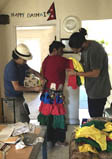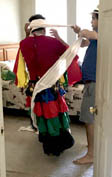“I work from childhood in this art field.” Raj Kapoor, Nepalese dancer

Within the small (roughly 1,500 people) but growing Nepalese community living in the Greater Boston area, talented musicians and dancers are dedicated to sharing their traditions with the world. Each week at Watertown’s Chulo Nepalese Restaurant, traditional and popular Nepalese music is performed live on a makeshift stage adjacent to the bar. One Saturday evening this past spring, I was there to introduce friends to this local taste of Himalayan Nepalese culture. Shyam Nepali, the sarangi player we’d met months earlier, had invited me to bring my fiddle and to sit in with the musicians. Midway through the evening, he introduced me to Raj Kapoor, saying he was talented dancer and folk dance choreographer who had recently relocated to Massachusetts from New York City.
Eager to learn more about Kapoor’s role in Nepalese dance, we arranged to meet for an interview. In the interim, Shyam sent me a copy of a clipping from the New York Times, showing a picture of Kapoor on stage at a 1998 Symphony Space performance. The concert, sponsored by the World Music Institute, featured Kapoor in the Nepalese Lakhe Mask Dance.

On June 26, I drove to Watertown to pick up Shyam Nepali. When I arrived, he let me know that Raj Kapoor preferred we come to him – he lives near a large park where he would have space to dance. So Shyam, a young Nepalese American man visiting from New York, and I got in my car and drove through Watertown traffic, finding our way to Kapoor’s home, a two-story small town house in a long row of town houses. After greeting Kapoor (they refer him this way), Kapoor and Shyam went into the bedroom just off the small living room so Kapoor could get into costume. The process takes two or three people. After donning a red shirt emblazoned with a gold hexagram and a multi-layered skirt, there was a lot of wrapping of material to create a head turban and colorful ribbons around the arms.



The belt was adorned with silver medallions depicting peacocks and dragons, as well as multiple brass bells that ring with the body’s motion.

And then there is the mask, which is both magnificent and frightening. Made of made of brightly painted papier–mâché, the mask is topped with a full head of coarse black hair from a yak’s tail.


Once Kapoor was dressed, we left the house and crossed the asphalt parking lot into Domenick Filippello Playground. The park is enormous and well groomed. After climbing up onto a bench to pose for pictures, Kapoor looked around for a suitable place to demonstrate the mask dance on the open grass.

Shyam offered to take video on my iPhone while I used my Nikon for stills. As we were scouting out spots, the sprinkler system suddenly came on, forcing us to scramble to move my equipment bag out of the way. The sprinklers did not discourage Kapoor from dancing.


In this video shot by Shyam, Kapoor demonstrates typical moves of the Lakhe Mask Dance. After Kapoor finished demonstrating, we packed up and went back inside so I could do a short interview. Although it began as a traditional Nepalese folk dance dating back over 5,000 years, the Lakhe dance is now also considered a classical dance.
The Newar, one of the castes that live in the Kathmandu Valley are credited with originating the Lakhe Mask Dance. It is done during Indra Jatra (a festival celebrated throughout Nepal, but especially in the Kathmandu Valley). Indra means God and Jatra means festival.
Kapoor almost sighs as he describes Nepal, “So many festivals and so many God and Goddess dances.” Shyam explains that Lakhe is a reincarnation of God Shiva, “It’s an angry reincarnation of him. He came to earth in that form of art to take away the bad things. His message is to come with good energy.” Kapoor adds, “When He’s dancing, He give a message: forget bad energy; come with good energy.”

I am struck by the similar function of the Lion Dance which is traditionally associated with the Chinese Lunar New Year. Also performed on urban streets, it symbolizes the cleansing of evil spirits lingering from the old year, bestowing only good fortune and prosperity in the New Year.]

Kapoor nods, “Exactly same thing, only expression is different.”
I asked about the colors (red, yellow, green, and black) on the mask, costume, and ribbons. Shyam interprets these as representing different energies – fire, the cosmos, the earth, “All are elements of where we are living. When bad energy [comes] from there, He can just blow away all.”
One of the remarkable things about the Lakhe dance during Indra Jatra is its duration. As Kapoor notes, “The Lakhe dance is not only for five minutes, ten minutes dance. This is continuously; they are dancing seven days, nine days. Traditionally and historically . . . [the people] who are doing Lakhe dance, they know they are doing one day, two day, three days continual dance, then they feel they have a lot of energy, come from reincarnation. It’s true. It’s a true thing.” Shyam adds that it is similar to trance.

Although Kapoor is not from the Newar dance caste known for the Lakhe tradition, he has been dancing, teaching, and choreographing in both traditional and classical Nepalese dance for many years. He came to the United States in 1996, settling in New York City. Soon after, he established the Dance Theater of Nepal.
When I asked if the Lakhe dance is being carried on here in the United States, Kapoor responded by saying, “Yes they carry, but only in community. But I did on stage, in New York City.”

And he will do that again, when we present a showcase concert on September 8, 2018 at the Shalin Liu Performance Center in Rockport, MA. Which makes me ponder, what are the implications of performing a tradition within the ethnic community in which it arose versus on a stage for those outside the tradition? Music and dance traditions take place all the time within local ethnic communities where they are woven into the fabric of everyday community life. Most go unnoticed by the mainstream public.
I leave you with Kapoor’s words, “The world is only one; we have to share.”
Maggie Holtzberg is Folk Arts & Heritage Manager at the Mass Cultural Council.
